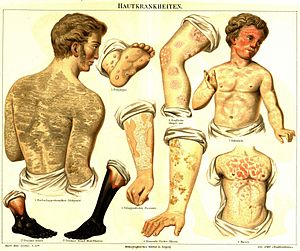Ichthyosis vulgaris
| Ichthyosis vulgaris | |
|---|---|
 |
|
| Ichthyosis vulgaris #1 (top-left) | |
| Classification and external resources | |
| Specialty | medical genetics |
| ICD-10 | Q80.0 |
| ICD-9-CM | 757.1 |
| OMIM | 146700 |
| DiseasesDB | 6647 |
| MedlinePlus | 001451 |
| eMedicine | derm/678 |
| MeSH | D016112 |
Ichthyosis vulgaris (also known as "Autosomal dominant ichthyosis," and "Ichthyosis simplex") is a skin disorder causing dry, scaly skin. It is the most common form of ichthyosis, affecting around 1 in 250 people. For this reason it is known as common ichthyosis. It is usually an autosomal dominant inherited disease (often associated with filaggrin), although a rare non-heritable version called acquired ichthyosis exists.
The symptoms of the inherited form of ichthyosis vulgaris are not usually present at birth but generally develop between 3 months and 5 years of age. The symptoms will often improve with age, although they may grow more severe again in old age.
The condition is not life-threatening; the impact on the patient, if it is a mild case, is generally restricted to mild itching and the social impact of having skin with an unusual appearance. People afflicted with mild cases have symptoms that include scaly patches on the shins, fine white scales on the forearms and upper arms, and rough palms. People with the mildest cases have no symptoms other than faint, tell-tale "mosaic lines" between the Achilles tendons and the calf muscles.
Severe cases, although rare, do exist. Severe cases entail the buildup of scales everywhere, with areas of the body that have a concentration of sweat glands being least affected. Areas where the skin rubs against each other, such as the armpits, the groin, and the "folded" areas of the elbow and knees, are less affected. When the buildup of scales is bad, the person with a severe case suffers from "prickly itch" when he or she needs to sweat but cannot because of the scales. Various topical treatments are available to "exfoliate" the scales. These include lotions that contain alpha-hydroxy acids.
Many people with severe ichthyosis have problems sweating due to the buildup of scales on the skin. This may lead to problems such as "prickly itch" or problems associated with overheating. The majority of people with vulgaris can sweat at least a little. Paradoxically this means most would be more comfortable living in a hot and humid climate. Sweating helps to shed scales which improves the appearance of the skin and prevents "prickly itch".
The dry skin will crack on digits or extremities and create bloody cuts. Skin is painful when inflamed and/or tight.
For children and adolescents: psychological precautions may include inconsistent self-image, mood fluctuates due to cyclical outbreaks, prone to addiction, may socially withdraw and/or separate when skin is noticeably infected, pre-occupation with appearance.
...
Wikipedia
